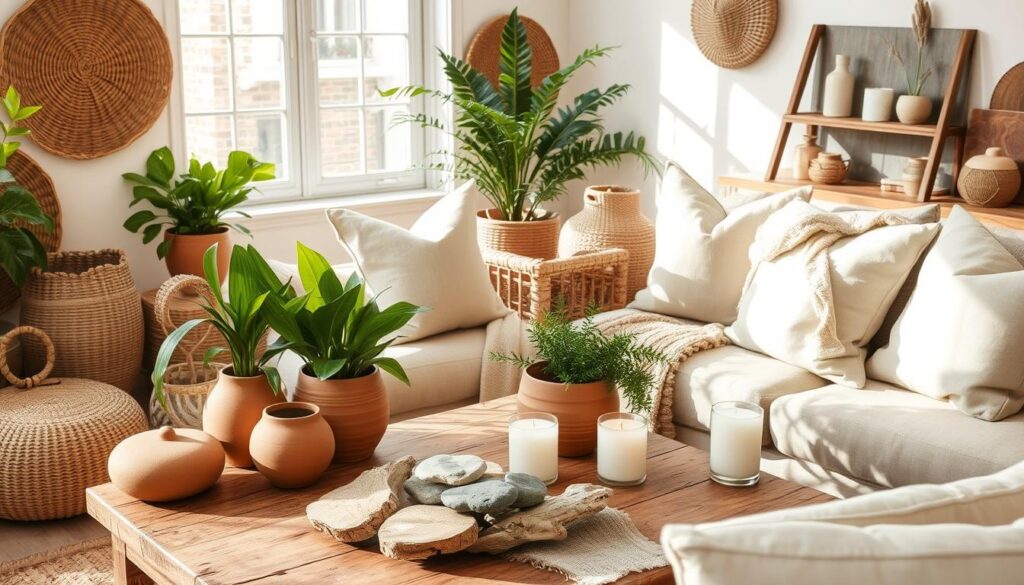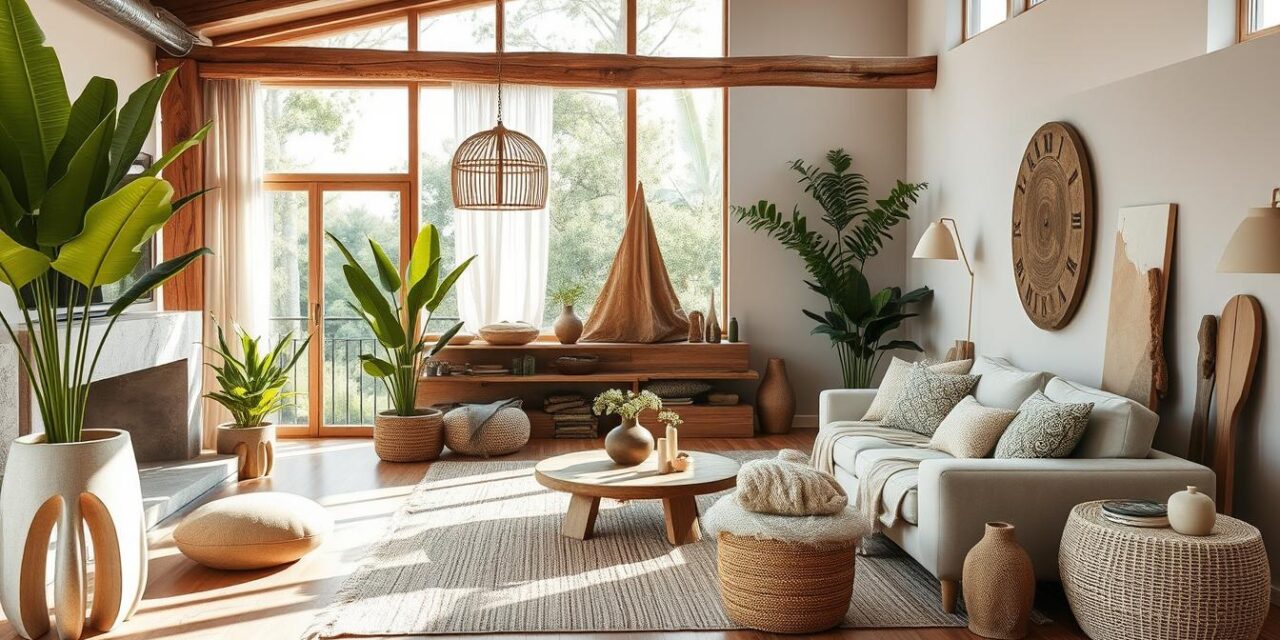In Australia, more people are choosing eco-friendly living. This includes organic room decor, which makes homes both beautiful and sustainable. It’s about creating spaces that are good for you and the planet.
By using organic elements and natural materials, homes become peaceful places. They help us feel better and care for the environment. It’s a way to make our homes into havens that support our health and the planet.
The trend of organic room decor shows Australians want to live in tune with nature. It’s about using materials that are good for the earth and last a long time. This means choosing furniture and textiles that are made from natural fibres and plants.
This approach to home design is not only stylish but also kind to the planet. It’s a better choice than traditional furniture, which can harm the environment.
Key Takeaways
- Organic room decor focuses on using natural, sustainable materials to create harmonious living spaces.
- This design approach promotes environmental responsibility and personal wellbeing.
- Australians are increasingly embracing eco-friendly home furnishings and biophilic design elements.
- Organic room decor offers a stylish and ethical alternative to traditional interior design.
- Incorporating organic elements can transform a space into a serene, nature-inspired sanctuary.
Understanding the Essence of Organic Room Decor
Organic apartment design is more than a trend. It’s a way to live in harmony with nature. It focuses on using natural elements to create spaces that are good for both body and soul.
The Philosophy Behind Natural Styling
Organic room decor is all about connecting with nature. It uses natural materials and design to bring peace into homes. This method values lasting beauty and care for the planet over fleeting trends.
Key Elements of Organic Design
- Natural textures, such as wood, stone, and rattan
- Earthy colour palettes inspired by nature
- Plant-based decor, including live plants and organic botanicals
- Sustainable materials, like bamboo, linen, and organic cotton
Benefits of Natural Décor Choices
Choosing organic design has many benefits. It improves air quality, reduces carbon footprint, and boosts mental health. It also strengthens our bond with nature, changing how we live.
| Benefit | Description |
|---|---|
| Air Quality Improvement | Live plants and natural materials clean the air, removing harmful toxins. |
| Environmental Sustainability | Using eco-friendly materials and avoiding synthetic chemicals reduces our environmental impact. |
| Enhanced Well-being | Biophilic design elements lower stress, improve mood, and increase calmness. |
“Organic design is not just about the aesthetic; it’s about creating a healthier, more sustainable living environment.”
Sustainable Materials for Eco-Friendly Interior Design
Creating a sustainable home starts with the materials we choose. Australians are now using natural and renewable resources in their homes. This helps reduce their environmental impact. Options like bamboo, reclaimed wood, organic cotton, and natural stone are popular for eco-friendly interior design and sustainable home decor.
Bamboo is a fast-growing grass used for flooring, furniture, and blinds. It’s strong and durable, making it a great choice over traditional hardwood. Reclaimed wood, from old buildings or abandoned materials, adds character and reduces the need for new wood.
Organic cotton is a favourite for its softness and low-impact production. It’s used in bedding and curtains, adding natural elegance. Natural stone, like marble or granite, is durable and has a timeless look, with low environmental impact.
| Sustainable Material | Application | Environmental Benefits |
|---|---|---|
| Bamboo | Flooring, furniture, window blinds | Fast-growing, renewable resource |
| Reclaimed Wood | Furniture, shelving, wall panelling | Repurposes existing materials, reduces demand for new timber |
| Organic Cotton | Bedding, curtains, upholstery | Biodegradable, low-impact production |
| Natural Stone | Countertops, flooring, wall tiles | Durable, low maintenance, minimal environmental impact |
Australians are at the forefront of using sustainable materials in their homes. They create spaces that are beautiful and good for the environment.
“By choosing eco-friendly materials, we can create beautiful and functional spaces that align with our values of sustainability and environmental stewardship.”
Incorporating Biophilic Design Elements in Your Space
Biophilic design brings nature into our built spaces to improve health and well-being. It helps us feel more connected to the outdoors. Let’s see how to add these elements to your home.
Living Plants and Natural Light
Bringing the outdoors in is key in biophilic design. Adding botanical inspired interiors can make your space feel alive. Use big windows and skylights to let in lots of natural light. This light can make you feel happier and more productive.
Natural Textures and Patterns
Using nature-themed home accents can make your space feel calm and grounded. Think about adding woven rugs, rattan furniture, stone, and wood. These materials add depth and interest. Look for patterns like leaf designs or wave shapes inspired by nature.
Water Features and Nature Sounds
Water can greatly affect our senses. Adding a water feature, like a fountain or indoor pond, can be very calming. Playing sounds of nature, like waves or birds, can also make your space feel more natural.
By adding these biophilic design elements, you can turn your home into a peaceful, nature-filled haven. It will nourish your mind, body, and soul.
Mediterranean Japandi: Fusion of Natural Styles
A new design fusion is taking shape – the Mediterranean Japandi style. It combines the warmth of the Mediterranean with Japanese minimalism. This mix is perfect for creating eco-friendly living spaces in Australia.
The Mediterranean Japandi style loves natural textures and simple designs. It uses earthy tones like terracotta and sage. Materials like natural stone and warm woods add a timeless feel.
For a japandi style small bedroom, focus on minimalism. Choose sleek beds and simple lighting. Keep surfaces clean to highlight the natural elements.
“The Mediterranean Japandi style is a harmonious dance between the earthy charm of the Mediterranean and the refined elegance of Japanese minimalism, resulting in a truly captivating and sustainable interior design solution.”
This style blends two design philosophies for a peaceful space. It’s a fresh, eco-friendly way to live in Australia.

Creating a Bright Earthy Bedroom Sanctuary
Making a cosy, organic bedroom is a peaceful place for rest. It uses natural materials and earthy colours. This creates a bright, welcoming space that follows organic room decor principles.
Natural Bedding Materials
Soft, breathable fabrics are key for a good night’s sleep. Choose bright earthy bedroom items like organic cotton, linen, or bamboo. These natural fibres are both luxurious and eco-friendly.
Organic Lighting Solutions
Add organic lighting that fits the natural look. Use table lamps with woven shades or pendant lights from rattan or bamboo. Dimmable lights help make the space cosy and inviting.
Earth-Toned Colour Palettes
Choose a calming, nature-inspired colour scheme for your bedroom. Shades like sage green, terracotta, and deep ochre are soothing. Mix these with natural wood and subtle patterns for a unified, organic room decor look.
“Bringing the outdoors in through organic materials and earthy tones can transform a bedroom into a peaceful sanctuary.”
Natural Home Accessories That Make a Statement
Adding natural home accessories is a simple way to make your rooms feel more organic and earthy. These items, like nature-themed accents and sustainable textiles, can change how your space looks and feels. They bring a calm and serene vibe to your home.
Using natural materials like jute, rattan, and recycled glass can make your space stand out. These materials add beauty and make your home more eco-friendly. They also bring a sustainable touch to your interior design.
Try adding a woven jute floor rug to your living room. Or, use a rustic rattan console table in your entryway. A set of handblown glass pendant lights above your dining table can also add a natural elegance.
- Incorporate natural woven baskets to store and display your belongings
- Style your bookshelves with ceramic vases and sculptural driftwood accents
- Drape a soft, organic cotton throw over the arm of your sofa for a cozy, lived-in feel
| Natural Home Accessory | Material | Benefit |
|---|---|---|
| Woven Jute Rug | Jute | Adds texture and warmth to any room |
| Rattan Armchair | Rattan | Blends seamlessly with nature-inspired decor |
| Handblown Glass Vase | Recycled Glass | Showcases the beauty of sustainable materials |
Choosing natural home accessories that fit your style can make your living spaces feel calm and authentic. It’s a way to show your true self through your home.

“Surround yourself with the things you love, and your space will reflect your true self.”
Transforming Small Spaces with Organic Elements
Creating a natural, organic feel in small spaces is a fun challenge. Whether it’s a Japandi-style bedroom or a small apartment, you can bring nature indoors. There are many ways to do this.
Space-Saving Natural Solutions
Choosing the right furniture is crucial in small spaces. Look for pieces made from sustainable materials like bamboo or rattan. They save space and add an earthy feel.
Choose a low bed and nightstands with storage to clear the floor. A natural-fibre rug that rolls up is also a great idea. It saves space and looks good.
Vertical Garden Integration
- Bring the outdoors in with a vertical garden. Wall-mounted plants or hanging baskets are great for small spaces. They let you enjoy nature without losing floor space.
- Choose easy-to-care-for plants like succulents or snake plants. They purify the air and make your japandi style small bedroom or organic apartment feel lush.
- Place your vertical garden near a window. This lets plants get sunlight and adds a warm glow to the room.
With a bit of creativity and focus on space-saving, plant-based room furnishings, you can turn any small area into a peaceful, natural retreat.
Basement Bedroom Ideas: Bringing Nature Below Ground
Creating a cozy basement bedroom can be a challenge, especially with little natural light. But, with the right design, you can turn this space into a peaceful, nature-inspired haven. Let’s look at some ideas that use biophilic design elements and organic room decor to bring nature indoors.
To deal with the lack of windows, use light therapy lamps. These lamps mimic sunlight, giving your space a calming glow. Add nature-inspired wall murals or big botanical prints to feel connected to the outdoors.
Reflective surfaces like mirrors and metallic accents can make your space feel brighter. Add organic textures like woven rugs, linen bedding, and wooden furniture for a cozy feel.
- Add biophilic design elements like plants, natural art, and water features to connect with nature.
- Choose earth-toned colours and natural materials for a cozy, basement bedroom ideas no windows retreat.
- Use mirrors and reflective surfaces to make the most of the light and add organic room decor elements.
By combining these basement bedroom ideas no windows, you can make your basement a peaceful, nature-inspired place. Embrace the challenge and discover your basement’s hidden potential.
Plant-Based Room Furnishings and Textiles
Plant-based room furnishings and textiles are changing the game in sustainable interior design. Made from renewable resources like hemp, organic cotton, and bamboo, they offer a natural alternative to synthetic materials. This meets the growing need for plant-based room furnishings and sustainable home decor.
Sustainable Fabric Choices
There’s a wide range of sustainable fabrics available, from organic cotton bedding to hemp curtains. These materials improve indoor air quality by reducing harmful chemicals. They also last long, making them a smart choice for those who care about the environment.
Natural Fibre Furniture
Natural fibre furniture is another area where plant-based room furnishings shine. Brands like Koala and Oz Design Furniture use materials like bamboo, rattan, and jute. These materials add a warm, organic feel to any room while supporting sustainable home decor.
| Sustainable Material | Benefits | Examples |
|---|---|---|
| Organic Cotton | Soft, breathable, and hypoallergenic | Bedding, curtains, rugs |
| Hemp | Durable, antimicrobial, and environmentally friendly | Upholstery, wall hangings, floor coverings |
| Bamboo | Rapid growth, high strength, and natural lustre | Furniture, flooring, window treatments |
Choosing plant-based room furnishings and sustainable home decor lets homeowners show their values. It also helps create a healthier, more eco-friendly future.
Organic Minimalist Home Styling Tips
Creating an organic minimalist home brings a calm, nature-inspired feel. It combines the simplicity of minimalism with the warmth of organic design. Start by decluttering and choosing multipurpose furniture that looks good and works well.
Add natural touches like woven baskets, terracotta pots, and wooden art. These items make your space interesting and connect you to nature. Use a colour scheme of earthy tones to highlight the beauty of your materials.
Use mirrors to reflect light and keep window coverings simple. This makes your space feel bigger and brings the outdoors in. Focus on function and natural materials to create a peaceful, organic minimalist home.





